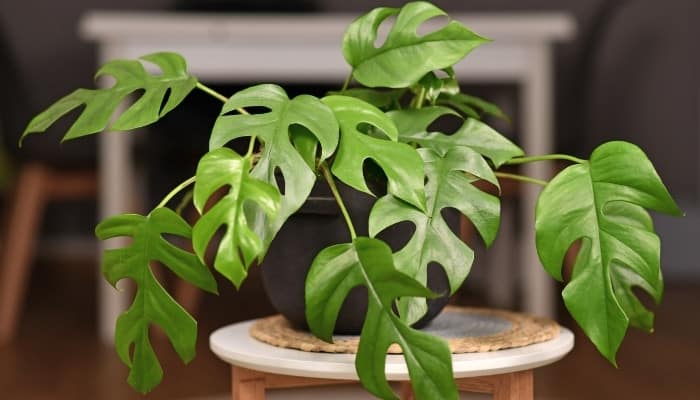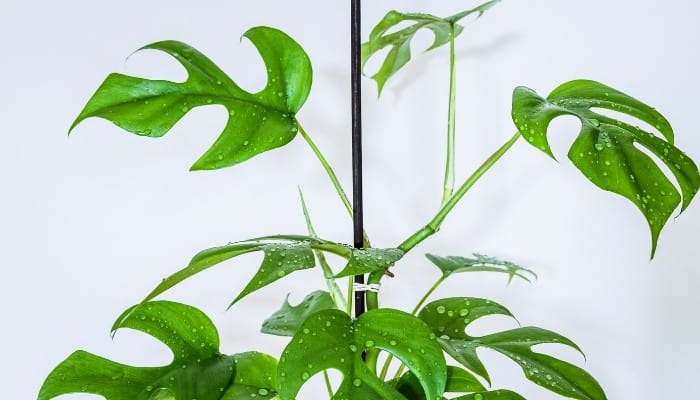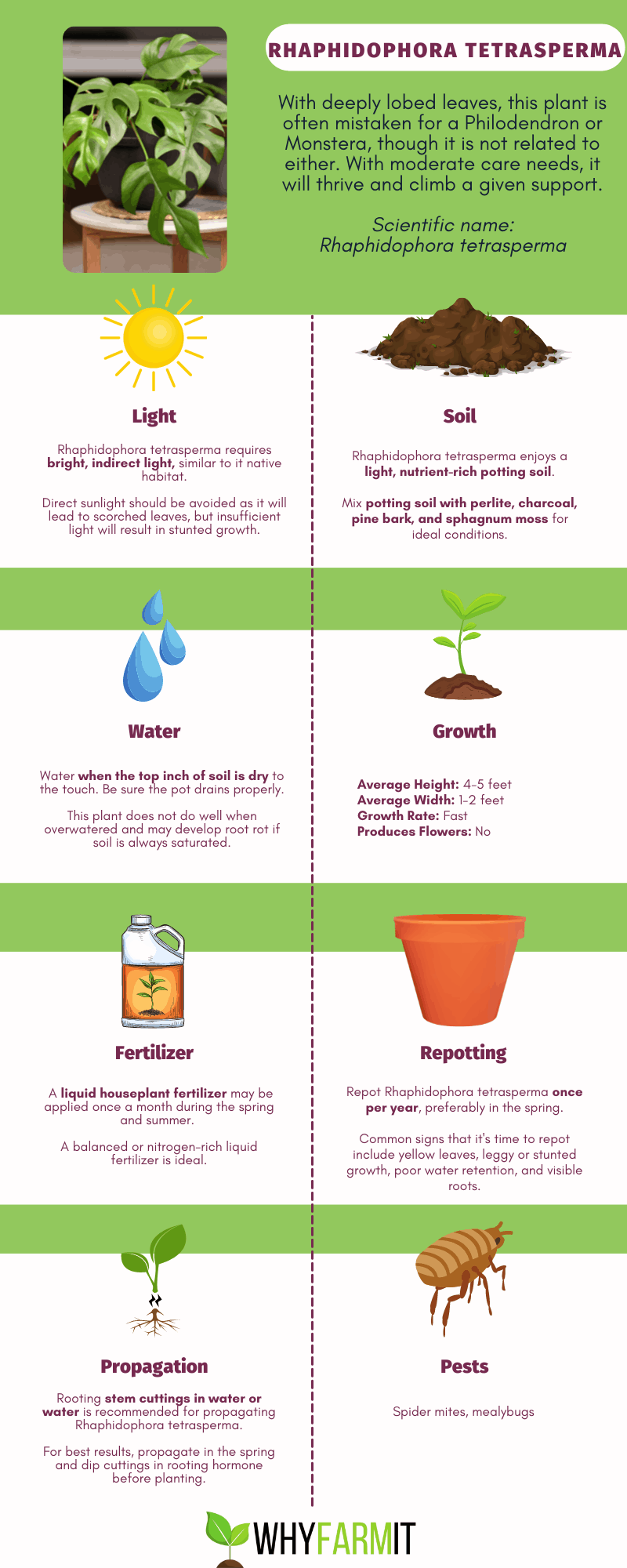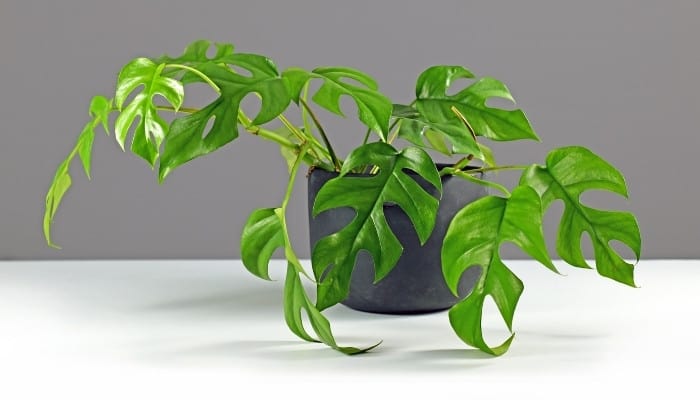This attractive climbing species, belonging to the aroid plant family, hails from the southern regions of Thailand and Malaysia.
Its love of warm, balmy conditions makes this tropical beauty the perfect indoor plant.
This plant looks similar to the Monstera deliciosa with its large emerald green and split leaves.
However, it should not be confused with the Philodendron or the Monstera.
The R. tetrasperma is a specific Araceae species and is a distant cousin to the Philodendron and peace lily.
How do you care for Rhaphidophora tetrasperma? This plant enjoys bright, indirect light and a light, rich soil that drains well. Recommended temperature range is between 55-85℉, and humidity should exceed 30%. Water when the top inch (2.5 cm) of soil is dry. Use a balanced or high-nitrogen fertilizer monthly during the growing season.
Caring for Rhaphidophora Tetrasperma: Basic Guidelines
The above table is a basic outline of the topics we will cover in this comprehensive care guide.
So, if you want to learn the secret to keeping your Rhaphidophora tetrasperma super healthy and content, read on and follow our informative steps to success.
The helpful hints and frequently asked questions sections include basic steps you can follow while caring for your lush Rhaphidophora tetrasperma.
Complete Care Guide for Rhaphidophora Tetrasperma
This extensive guide will provide the necessary information required for the proper care of the Raphidophoa tetrasperma.
Rhaphidophora Tetrasperma at a Glance
- Scientific Name: Rhaphidophora tetrasperma
- Plant Type: Tropical
- Average Height: 4-5 feet (121-152 cm) indoors
- Average Width: 1-2 feet (30 – 60 cm)
- Growth Rate: Fast
- Produces Flowers: No
- Common Pests: Spider mites, mealybugs
- Level of Care: Moderate
What To Do When You First Get Your Rhaphidophora Tetrasperma
Ensure the plant is in an adequately sized container with sufficient drainage to prevent waterlogged soil.
Position the plant in a room that receives lots of bright indirect light. Place the plant on a pebble tray filled with water to maintain comfortable humidity levels of approximately 30%.
Ideal Soil for Rhaphidophora Tetrasperma
The Rhaphidophora tetrasperma enjoys a light, well-draining soil that retains moisture without becoming waterlogged. Slightly acidic soil pH of 6 – 6.6 is ideal.
Mix equal parts potting soil, perlite, horticultural charcoal, pine bark, and shredded sphagnum moss to create well-aerated soil.
Rhaphidophora Tetrasperma Water Requirements
This plant is sensitive to overwatering and will quickly start to develop yellow leaves and root rot.
Use your index finger to check when the top 1 inch (2.5 cm) of soil is dry before hauling out the watering jug. Little and often is the key to keeping this plant happily hydrated.
Rhaphidophora Tetrasperma Lighting Needs
The Raphidorphora tetrasperma grows in trees below the roof canopy of the forest.
It enjoys brighter light than foliage found growing on the forest floor but less light than the foliage found at the top directly in the sun’s light.
Therefore, place the plant in a brightly lit room but out of direct sunlight. If you put the plant outside in the summer, ensure it has access to shade to prevent the leaves from burning.
The correct lighting is essential for this plant as too little light can reduce growth speed.
Ideal Temperature Range for Rhaphidophora Tetrasperma
As this is a tropical plant, it naturally prefers a warmer temperature range and is not frost-hardy. Optimum temperatures for this plant are between 55-85℉ (13-30℃).
Ideal Humidity Level for Rhaphidophora Tetrasperma
Humidity levels for the Rhaphidophora tetrasperma differ depending on where they are grown.
Indoor humidity levels should be 30% plus, but if grown outdoors, the climate needs to adequately provide high levels of rainfall and humidity over 40%.
Best Location for Rhaphidophora Tetrasperma
Rooms that can provide bright indirect or filtered sunlight are acceptable for this plant.
Kitchens and bathrooms with windows facing southwest or west can provide the necessary light levels and humid conditions that replicate this plant’s natural environment.
Rhaphidophora Tetrasperma Growth Habits
The Rhaphidophora tetrasperma is the Speedy Gonzales of plants.
When cared for in the right conditions, it can reach heights of 4-5 feet (121-152 cm) indoors and a whopping 12 feet (365 cm) outdoors.
Don’t panic! It won’t take over the house as a bit of pruning does help to keep this plant nice and compact, perfect for indoors.
Fertilization Type & Schedule for Rhaphidophora Tetrasperma
Use a well-balanced or nitrogen-rich liquid fertilizer to feed your plant in the growing season.
Remember that overfeeding your plant can cause the soil to become clogged with excess minerals. This can cause decreased growth and plant death.
Signs of Nutrient Deficiency
Yellowing leaves coupled with slow growth are classic signs of a lack of nutrients. Vines become leggy, and foliage appears smaller.
Ensure the plant is receiving enough indirect or filtered light.
Check the soil is moist but not soggy and that the plant has not become rootbound, preventing it from drawing sufficient nutrients from the soil.
Pruning Rhaphidophora Tetrasperma
If growing this plant indoors, pruning is needed to keep it compact and prevent it from outgrowing its space.
Use clean, sterilized scissors or a knife to remove dead and diseased leaves to keep the plant healthy.
You can also pinch off new vine tips to maintain the plant size of indoor Rhaphidophora tetrasperma.
Does Rhaphidophora Tetrasperma Produce Flowers?
It is extremely rare for this plant to flower, and so it is mainly grown for its gorgeous vining foliage and is considered non-flowering.
Is Rhaphidophora Tetrasperma Toxic?
This plant is toxic to pets. The leaves of the Rhaphidophora tetrasperma contain insoluble calcium oxalates that can cause drooling, oral irritation, and vomiting if swallowed.
Rhaphidophora Tetrasperma Propagation
You can quickly propagate the Rhaphidophora tetrasperma using stem clippings grown in soil or water.
Propagation is best done in the spring during the plant’s active growing season.
Propagation of Rhaphidophora Tetrasperma Using Stem Cuttings
This is the most common method used to propagate the Rhaphidophora tetrasperma.
To reproduce this plant successfully, you’ll need a pair of clean, sterilized scissors, a clean jam jar, and fresh water or a container of new soil.
In addition, it is necessary to wear protective gloves when handling this plant due to skin-irritating toxins in its leaves.
1. Decide Which Growing Medium You Will Be Using for the Cutting
The stem cuttings can be grown in water or soil, depending on your preference. If growing the plant in water, half fill the jam jar with fresh warm water.
Or, if using soil as the growth medium, half fill the container with new well-aerated soil.
2. Select a Healthy Stem for the Cutting With Three to Five Leaves
Using the sterilized scissors, snip off a healthy stem. Ensure your stem has a node and three to five leaves.
3. Remove Leaves at the Leaf Node
Carefully strip the leaves off the stem at the leaf node. There should be 3-6 inches (7-15 cm) of the stem before the first set of leaves.
4. Dip the Cutting Into Rooting Hormone Powder
Dip the cutting gently into the rooting powder and tap excess powder off. I’ve had great success with this one.
After that, place it in the jar of clean, warm water or the container of fresh soil. Keep in mind that the soil should be well-draining.
5. Place the Container or Jar in a Warm Area
Position the container in a warm spot with access to bright but indirect light. Check the soil remains consistently moist, and if growing in a jar, top the water up regularly.
Roots can take two to three weeks to develop.
Repotting Rhaphidophora Tetrasperma
The Rhaphidophora tetrasperma is a naturally fast-growing plant and will require frequent repotting to prevent it from becoming rootbound.
Therefore, we recommend that the plant is repotted annually. This is also an excellent time to check for signs of root rot, which can be trimmed using a sterile knife.
When To Repot Rhaphidophora Tetrasperma
When you notice yellow leaves, leggy growth, and roots becoming visible either at the soil line or beneath the pot, it’s time for a new, slightly larger pot.
Also, if growth has noticeably slowed and/or the soil no longer retains moisture as it should, repotting is recommended.
Signs That It’s Time To Repot
- Yellowing foliage
- Reduced and leggy growth
- Roots become visible above the soil
- Roots appear through the container’s drainage holes
How To Repot Rhaphidophora Tetrasperma
You will need some basic essentials when repotting the Rhaphidophora tetrasperma, all of which can be found in your garden shed: protective gloves, new plant pot, fresh potting mix, and some water.
Note this plant is toxic and can cause skin irritation; therefore, protective gloves are advised when handling its leaves directly.
1. Select a Container 2-3 inches Larger Than the Current Container
A ceramic or terracotta pot is a great container for this plant as it can retain and release moisture, creating humidity, which these plants love.
2. Carefully Remove the Plant From Its Container
Remove the plant from the container, holding the root ball in one hand. Check for signs of root rot. Trim black mushy or diseased roots with a sterilized pair of scissors or knife.
3. Loosen the Old Soil With Your Fingers
Using your fingers, gently remove the old excess soil from the roots.
When handling the roots, be careful not to break them off unnecessarily, as the Rhaphidophora tetrasperma has a delicate root system.
4. Half Fill the New Container With Fresh Soil
Select a peat-based soil, and half fill the new container. Next, place the Rhaphidophora tetrasperma into the pot, and fill in the leftover space with the rest of the fresh soil.
5. Water the Plant and Check the Soil Is Draining Well
Water the plant to ensure the soil is draining water well. Place the plant in bright, indirect light, and continue to care for it as per the usual guidelines.
Rhaphidophora Tetrasperma Common Problems & Solutions That Work
Rhaphidophora Tetrasperma Common Pests
The tropical Rhaphidophora tetrasperma is not easily plagued by pests. However, the spider mite is one of the plants’ most notorious pests.
Spider mites are particularly partial to dining on the Rhaphidophora tetrasperma plant’s sumptuous leaves.
Spider Mites
Signs of Trouble
Yellowing leaves and silky webs are seen on the underside of the leaves.
Solution
Mix a solution of neem oil (try this organic neem), liquid soap, and warm water. Use this solution to spray the plant, paying close attention to the underside of leaves and stems.
Continue to treat the plant every two weeks to keep the spider mites away.
Prevention
Inspect the plant regularly for signs of infestation. Use a neem oil solution to spray the leaves every two weeks.
Increase the humidity levels around the plant with the use of a pebble tray or humidifier, like this extra-quiet one, as spider mites prefer a warm and dry environment.
Mealybugs
Signs of Trouble
Yellowing leaves, white cottony residue, sooty mold, and honeydew secretions are all common signs of mealybugs.
Solution
Keep the plant separate from other household plants. Then, spray the leaves with a spray bottle or shower head to dislodge as many bugs as possible.
Following that, spray the plant with horticultural soap or isopropyl alcohol solution.
Prevention
Inspect the plant regularly for signs of infestation. Use a neem oil solution to spray the leaves every other week.
Increase the humidity levels around the plant to discourage spider mites, using a pebble tray or humidifier because they prefer a warm, dry environment.
Rhaphidophora Tetrasperma Common Diseases
This plant grows in wild forest conditions and certainly knows how to look after itself in most instances.
However, its nemesis is, as with all dry soil-loving plants, the dreaded root rot.
Waterlogged soil poses a big problem for this plant, and if allowed to stand in water, its roots soon develop issues that cause a speedy death.
Root Rot
Signs of Trouble
Signs of root rot are yellowing leaves, stunted growth, and stem collapse.
Solution
Remove the plant from its container and inspect the roots.
Their color should be healthy yellow brown. If they have gone black and mushy, use a sterilized knife to remove infected roots.
Clean the container using warm soapy water. This will kill any disease-carrying pathogens left in the container. Rinse the healthy roots with warm water, and repot in fresh soil.
Prevention
Overwatering is the leading cause of root rot, but this can be exacerbated by insufficient light, a lack of drainage holes, or incorrect soil.
To prevent root rot in the Rhaphidophora tetrasperma, use light aerated soil, provide lots of indirect sunlight, and ensure the container has enough drainage.
You can also make use of self-watering plant containers to aid in preventing overwatering, like this planter that also helps maintain proper soil aeration.
Other Common Problems
As with all houseplants, the Rhaphidophora tetrasperma can be affected by some minor problems that are easily resolved.
Curling Leaves
Signs of Trouble
Curling leaves with dry, crispy tips.
Solution
Over-fertilizing is the main reason for leaf curl. This happens when the soil has a buildup of excess mineral salts.
Place the plant in the sink, and slowly pour water into the soil for 3-4 minutes. Allow all the water to drain through the soil, and then place the plant back onto its drip tray.
Remember to empty any excess water that collects in the drip tray to prevent root rot.
Prevention
All indoor plants will suffer from a buildup of excess minerals over time, even if you follow a strict feeding regime.
Flush the soil every four months to prevent mineral buildup, and apply a liquid fertilizer one month after each flush.
Rhaphidophora Tetrasperma Common Questions

How Much Does Rhaphidophora Tetrasperma Cost?
The Rhaphidophora tetrasperma has been known to be pretty pricey. For example, in 2020, a rare variegated specimen sold in New Zealand for a whopping $8,000.
However, this plant doesn’t have to cost the earth and can be bought online for approximately $20. A clever way to reduce its cost is to purchase a cutting.
How Do You Identify Rhaphidophora Tetrasperma?
The Rhaphidophora tetrasperma has green leafy foliage with split leaves that closely resemble the Monstera deliciosa.
This plant is the often called the Swiss cheese plant or a mini Monstera, though neither name is quite accurate.
Is Rhaphidophora Tetrasperma a Philodendron?
This particular plant is not directly related to the Philodendron or Monstera but is a species of the Araceae family.
How Do You Train Rhaphidophora Tetrasperma To Climb?
Training the Rhaphidophora tetrasperma is fairly easy.
This plant is a natural climber and, if given support such as a trellis to support its aerial roots, it will happily climb without much encouragement.
How Do I Make a Mini Monstera Fuller?
Rhaphidophora tetrasperma can become leggy over time and you may want to make it a bit fuller or “bushier.”
Prune the leggy growth with sterilized scissors to encourage compact, fuller growth. Pinching off the vine tips can also promote fuller growth.
Can Rhaphidophora Tetrasperma Be Variegated?
Variegated Rhaphidophora tetrasperma are considered very rare. Often these variegations are created with the use of chemicals during tissue culture propagation.
Are There Different Types of Rhaphidophora Tetrasperma?
There are many different types of Rhaphidophora, as this genus contains over 100 species found in the exotic jungles of southeast Asia.
However, there is very little information on any tetrasperma cultivars at this time.
Is Philodendron Minima the Same as Tetrasperma?
These are not the same plant, even though many plant sellers list them as one at the same.
They often get confused because they are very similar in looks, resulting in the misconception that they belong to the same plant genus.
Rhaphidophora Tetrasperma vs. Monstera Deliciosa
The Monstera deliciosa has large leathery leaves that can grow to 3 feet (1 meter) in width and length.
In contrast, the Rhaphidophora tetrasperma has smaller leaves ranging between 10-12 inches (25-30 cm). Both of these plants have split leaves.
5 Key Tips for Success With Rhaphidophora Tetrasperma

- Provide support or a trellis to encourage the plant to climb.
- Use a humidifier or pebble tray to increase humidity levels.
- Provide lots of bright diffused/indirect sunlight.
- Avoid overwatering with the use of self-watering pots.
- Ensure soil drains well and is nutrient rich.
Conclusion
This happy-go-lucky plant is gorgeously exotic without the painful diva qualities that come with most warmth-loving plants.
Happy to settle into a moderately warm and bright environment the Rhaphidophora tetrasperma will gladly flourish and keep you enchanted with its fascinating leaf formation.


